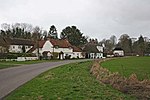Amport House
1857 establishments in EnglandAndover, HampshireCountry houses in HampshireElizabethan architectureGardens by Gertrude Jekyll ... and 10 more
Gardens in HampshireGrade II listed houses in HampshireHouses completed in 1857Installations of the British ArmyMilitary chaplainsRoyal Air Force stations in HampshireRoyal Army Chaplains' DepartmentRoyal Navy bases in HampshireTudor Revival architecture in EnglandWorks of Edwin Lutyens in England

Amport House is a country house near the village of Amport, Andover, Hampshire, England. It is a Grade II listed building. The house was built in 1857 by John Paulet, 14th Marquess of Winchester. After being requisitioned during the Second World War, the house had various military uses and was the home of the Armed Forces Chaplaincy Centre until March 2020, when it was sold by the Ministry of Defence.
Excerpt from the Wikipedia article Amport House (License: CC BY-SA 3.0, Authors, Images).Amport House
Furzedown Lane, Test Valley Amport
Geographical coordinates (GPS) Address Nearby Places Show on map
Geographical coordinates (GPS)
| Latitude | Longitude |
|---|---|
| N 51.195 ° | E -1.5761 ° |
Address
Furzedown Lane
Furzedown Lane
SP11 8BS Test Valley, Amport
England, United Kingdom
Open on Google Maps






